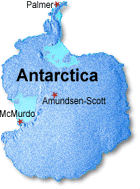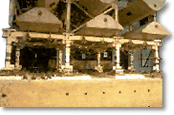 |
 |
'Tis the Season
|

1997-98 Antarctic Research Season Underway
A new research season is underway in Antarctica, encompassing
175 research projects supported by the National Science
Foundation (NSF), the federal agency that funds and
manages the U.S. Antarctic Program. Studies are based
out of three research stations -- McMurdo, Amundsen-Scott
South Pole and Palmer -- as well as on two research
vessels, the Nathaniel B. Palmer and a new vessel,
the Lawrence M. Gould. Research covers earth sciences,
glaciology, biology, medicine, oceanography, meteorology,
aeronomy and astrophysics.
More...
|
 |

Statement
by National Science Board
Chair Richard Zare on Domain Names
The Administration
has stated that it supports the continued privatization
and commercialization of the Internet and is committed
to completing the transition to private sector governance.
The National Science Board (NSB) agrees, and has issued
a resolution that the NSF should no longer be involved
in domain name registration.
More...
|
 |

Math Curriculum Improves Student Performance
After five years of
Everyday Mathematics -- an innovative, NSF-supported
elementary school math curriculum -- Hopewell Valley
School District students in New Jersey are showing
some significant improvements (to the tune of several
percentile points) on the Comprehensive Testing Program
(CTP III) test. The results emerged from a controlled
study of more than 200 elementary school students
that compared Everyday Mathematics to a more traditional
math program in Hopewell Valley schools.
More...
|
 |

|
 |
Shake, Rattle & Roll:
The Science and Engineering of Earthquakes
To understand
Jacobo Bielak's work, think of California's
San Fernando Valley as a bowl of gelatin.
The gelatin isn't very well mixed. Parts
of it shake strongly with an earthquake,
others much less. Like a bowl of gelatin,
the valley, a sedimentary basin, experiences
earthquake ground motion that varies considerably
from one location to another. Determining
the severity of ground motion and understanding
why certain regions shake more strongly
than others is an important step towards
better earthquake-resistant design. Bielak,
a civil engineer at Carnegie Mellon University
(CMU), is the principal investigator of
NSF's Grand Challenge Quake Project, funded
by NSF's Earthquake Hazard Mitigation
Program (EHMP), part of the National Earthquake
Hazards Reduction Program (NEHRP). The
goal of this project is not to predict
earthquakes, says Bielak, but rather to
predict what will happen when an earthquake
does occur.
More...

|
|
Photo courtesy of NCEER
This Friction Pendulum
System (FPS) has been installed in
a six-story model before being placed
on a shake table at the National Center
of Earthquake Engineering Research.
|
|

|
 
|

